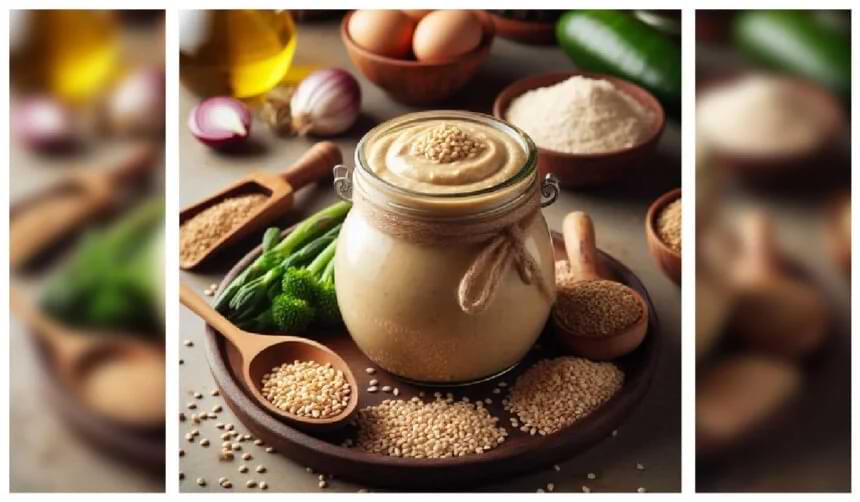Introduction
Tahini is a smooth, creamy paste made by grinding sesame seeds. Loved by food lovers worldwide, it boasts a rich, nutty flavour and a silky texture. Some call it “tahini” or “tahina,” but all names point to the same thing. This paste is not only delicious but also rich in nutrients, making it a favourite in both traditional and contemporary cooking.
From ancient times to today’s kitchens, Tahini has been valued for its versatility and health benefits. It can be used in savoury and sweet recipes, proving why it has become a global favourite. In this guide, we’ll cover everything: its meaning, history, how it’s made, its benefits, and creative ways to use it.
Meaning of Tahini
Tahini is a thick, smooth paste made from sesame seeds. It can be prepared with hulled seeds (outer shell removed) for a lighter, softer taste, or unhulled seeds (with shell) for a darker, stronger, slightly bitter flavour. It’s best known as the key ingredient in hummus and baba ghanoush, but it also works well in sauces, desserts, and health-focused diets. Its unique nutty flavour with a hint of bitterness makes meals more exciting.
There’s plenty more to explore check out our other posts!
The History of Tahini
Tahini has a long history, dating back thousands of years. Its roots go back to Mesopotamia, Egypt, and the Indus Valley, where sesame seeds were among the first crops grown for oil (around 3000 BCE). In places like Persia and Babylon, sesame was linked with health and even used in rituals.
Tahini originated as a byproduct of oil production and gained popularity due to its ease of storage and high energy content, making it ideal for travellers and soldiers. In the Middle East, it became a symbol of hospitality. Over time, it spread worldwide, loved by vegans, health-conscious people, and top chefs.
How Tahini Is Made
Traditional Method: Sesame seeds are lightly toasted, then ground between stone wheels until smooth. This method keeps the natural flavour and nutrients. Usually, only sesame seeds and a little salt are used.
Modern Method: Factories roast the seeds and grind them with machines to get a uniform texture. This is faster and consistent, but some say traditional Tahini tastes richer.
Either way, the result is a nutritious paste used in countless recipes.
Types of Tahini
-
Hulled Tahini → Light, smooth, mild, suitable for desserts and sauces
-
Unhulled Tahini → Darker, richer in fibre, slightly bitter, great for intense dishes
-
LTahiniahini → From lightly roasted seeds, mild taste
-
Tahiniahini → From deeply roasted seeds, strong, toasted flavour
-
FlavoureTahiniini → Garlic, chocolate, chilli, or herb-infused versions
Choosing the type depends on how you plan to use it; lighter ones are suitable for sweets and dressings, while darker ones are best suited for bold dishes.
Nutritional Value ofTahinii
Tahini is packed with nutrients:
-
Healthy fats (omega-3 and omega-6) → good for heart health
-
Protein (about 5g per 2 tbsp) → great for vegetarians and vegans
-
Minerals → calcium, iron, magnesium, zinc, phosphorus
-
Vitamins → especially B1 (thiamine) and vitamin E
-
Antioxidants → help fight inflammation
It’s calorie-rich (180–200 per 2 tbsp), but very filling and nourishing, making it a wise choice for a healthy diet.
Health Benefits of Tahini
-
Heart Health → Lowers bad cholesterol (LDL), raises good cholesterol (HDL)
-
Bone Strength → High in calcium and magnesium
-
Energy & Muscle Support → Protein + iron boost strength and energy
-
Antioxidants → Protect against disease and support hormones
-
Skin & Hair Care → Vitamin E and natural oils nourish skin and hair
-
Digestive Health → Rich in fibre for better digestion
-
Diet-Friendly → Gluten-free, dairy-free, and nut-free (suitable for keto, vegan, paleo)
Common Mistakes with Tahini
-
Using it straight from the jar without thinning → makes it too bitter or heavy.
-
Storing it at room temperature for too long → can spoil it.
-
Over-roasting seeds → creates a burnt flavour
-
Forgetting to stir when oil separates → makes it dry and uneven
Tip: Always refrigerate after opening and stir well before using.
Creative Ways to Use Tahini
-
Mix with lemon, garlic, and olive oil → creamy salad dressing or dip
-
Add to oatmeal or smoothies → extra flavour + protein
-
Spread on toast with honey or bananas
-
Drizzle on roasted veggies or grain bowls
-
Use as a thickener in soups and stews
-
Replace the peanut butter sauce in noodles with Tahini
Sweet Recipes with Tahini
-
Brownies → keep them moist with a nutty taste
-
Cookies → chewy texture, unique flavour
-
Halva → traditional Tahini made with Tahini sugar or honey
-
Pancakes/Waffles topping → drizzle with tahini + chocolate or maple syrup
Make Tahini at Home
-
Toast 2 cups of sesame seeds until golden
-
Cool slightly, then blend in a food processor
-
Add 2–4 tbsp oil (sesame, sunflower, or grapeseed)
-
Blend until creamy, adding more oil if needed
-
Store in a jar in the fridge (lasts up to 1 month)
How to Store Tahini
-
Unopened jars → cool, dry pantry
-
Opened jars → fridge for freshness
-
Homemade tTahini→ Always refrigerate, finish in 3–4 weeks
-
Stir well before using to mix the oils
Where to Buy Tahini
-
Supermarkets (international or nut butter section)
-
Middle Eastern / Mediterranean stores → authentic taste
-
Health food stores → organic/raw versions
-
Online shops (Amazon, Thrive Market, etc.)
Check label: Tahinie has only sesame seeds (and maybe salt).
Non-Food Uses of Tahhiini
-
Skincare → hydrating mask (mix with honey or yogurt)
-
Hair care → as a natural conditioner
-
Scrub base → mix with sugar/oats for exfoliation
-
Homemade energy bars → bind ingredients naturally
Tahhiini Around the World
-
Middle East → hummus, baba ghanoush, falafel drizzle
-
Mediterranean → seafood, grilled veggies
-
North Africa → stews, couscous
-
Asia → noodle sauces, dumplings, stir-fries
-
Western cuisine → vegan cheese spreads, Buddha bowls, baking
Starting a Tahini Brand
-
Source high-quality sesame seeds
-
Offer flavour varieties (chocolate, chilli, herb, etc.)
-
Use eco-friendly jars with clear labels
-
Target vegan, paleo, and healthy-eating communities
-
Sell through local stores, markets, and online
-
Use blogs, recipes, and sampling events to promote
Want to learn more? Our full collection of posts is ready for you!
Conclusion:
Tahini is more than a spread; it’s a healthy, historic, and versatile food loved around the world. From dips and sauces to desserts and even skincare, it adds flavour, nutrition, and creativity to your life. Adding Tahini to your pantry means enjoying a timeless ingredient that connects tradition with modern wellness.
FAQs
What is Tahin made from?
Tahini is made from roasted sesame seeds ground into a smooth paste. Sometimes a little oil is added.
ITahinini healthy?
Yes! It has good fats, protein, fibre, and minerals that support the heart, bones, and energy levels.
How do you use Tahini in cooking?
It works in dips, dressings, sauces, baking, and desserts. You can drizzle it, spread it, or blend it into smoothies.
Can I make Tahini at home?
Yes. Toast sesame seeds, blend with oil, and store in a jar in the fridge for a month.
What does Tahini taste like?
It’s nutty, creamy, and a little bitter. Hulled seeds taste milder; unhulled seeds taste stronger.




